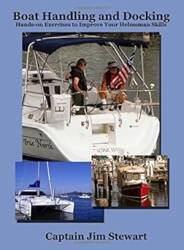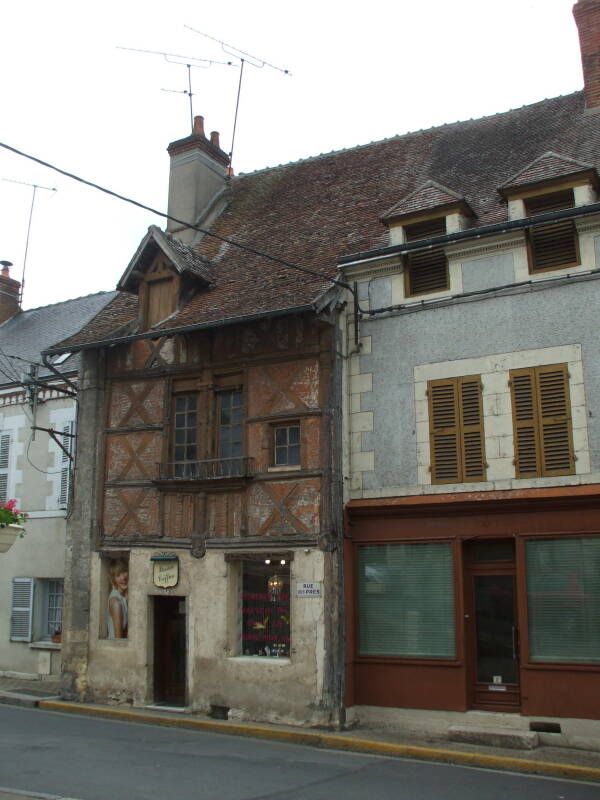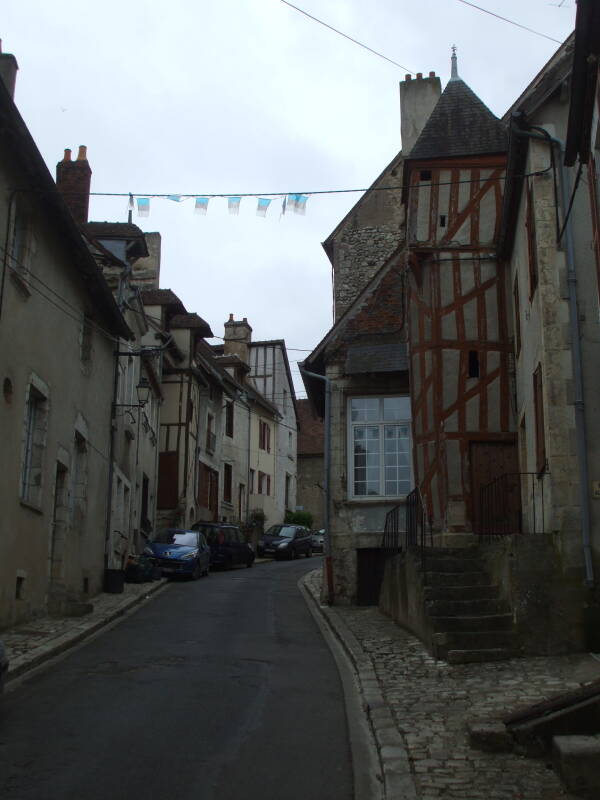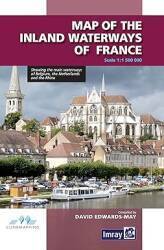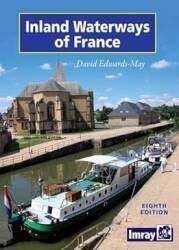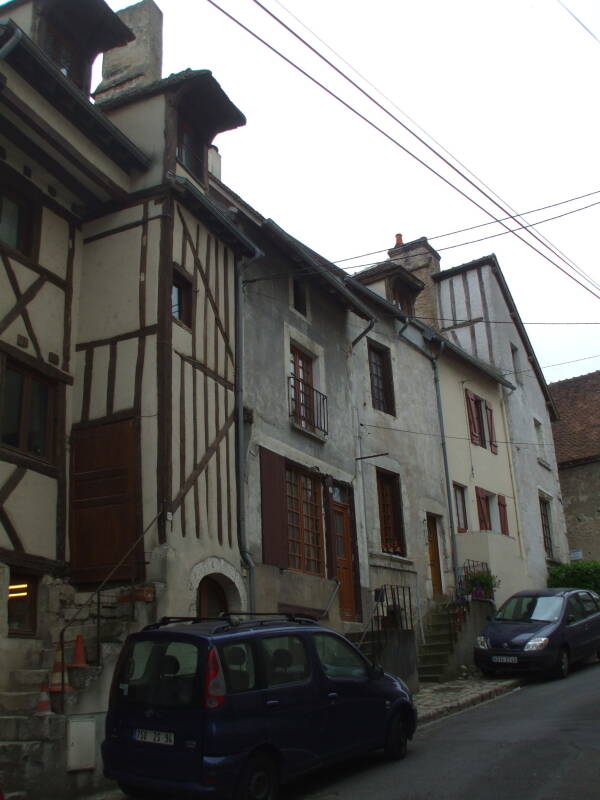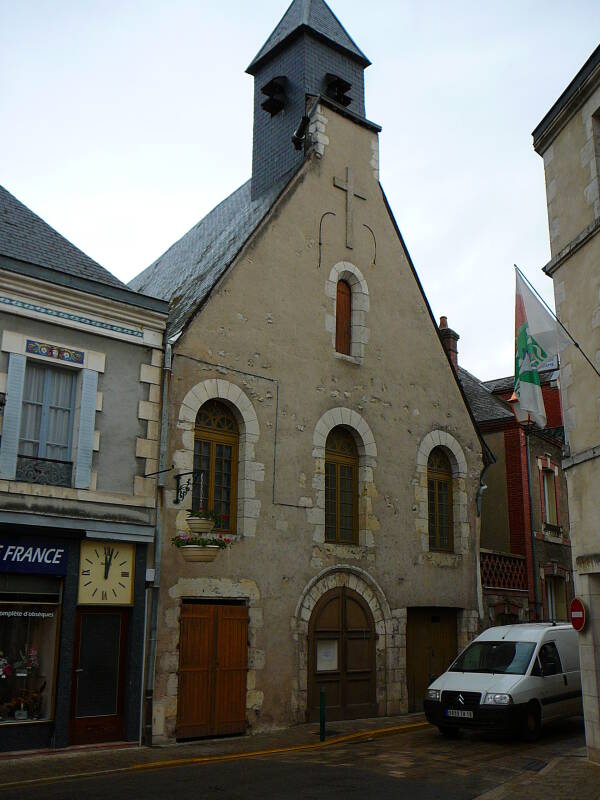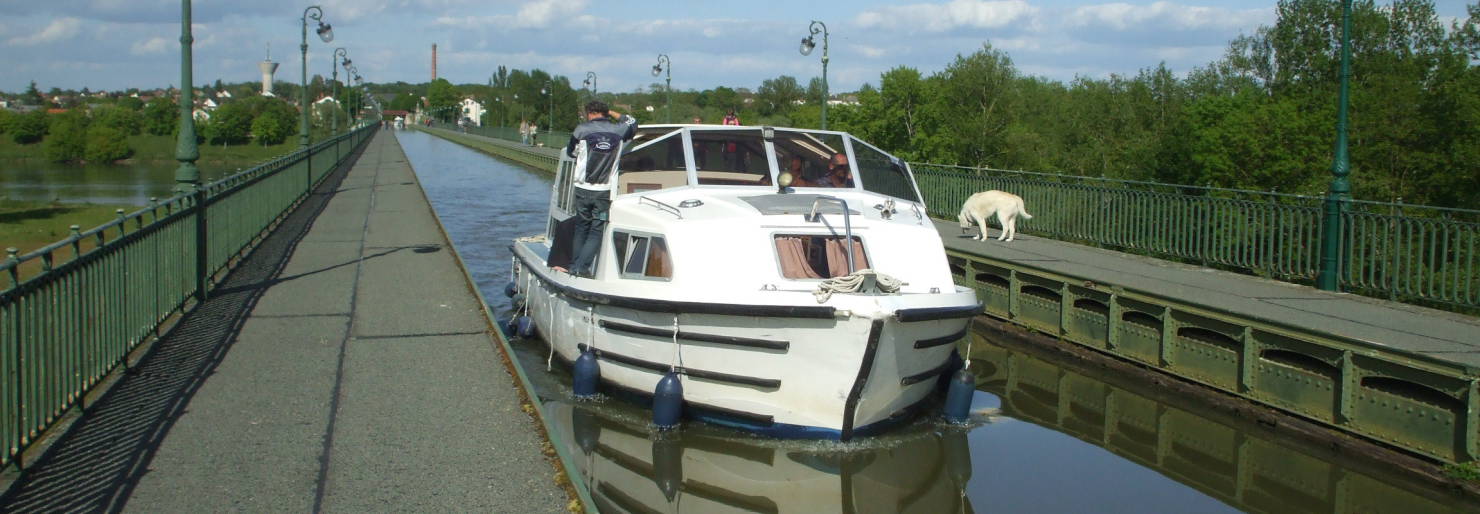
Briare to Beaulieu-sur-Loire
South on the Canal Latéral à la Loire from Briare
We have spent a day exploring Briare, a small town but also a significant marine transport hub since the 1600s. Now we are headed south on the Canal Latéral à la Loire from Briare to Decize in a rented canal boat. Over the next week we will cover 130 kilometers and pass through 23 locks. These descriptions and pictures are a composite of two trips. In 2005 we started from Briare. In 2012 we started at Châtillon-sur-Loire, traveling back five to six kilometers to cross the Loire on the Canal Bridge to Briare, immediately turning around and returning to continue south past Saint-Firmin-sur-Loire and Châtillon-sur-Loire before stopping for the first night at Beaulieu-sur-Loire. Above we see a boat crossing the Canal Bridge from Briare to Saint-Firmin-sur-Loire. The following map shows our route across the Loire and along the canal from Briare to Beaulieu-sur-Loire.
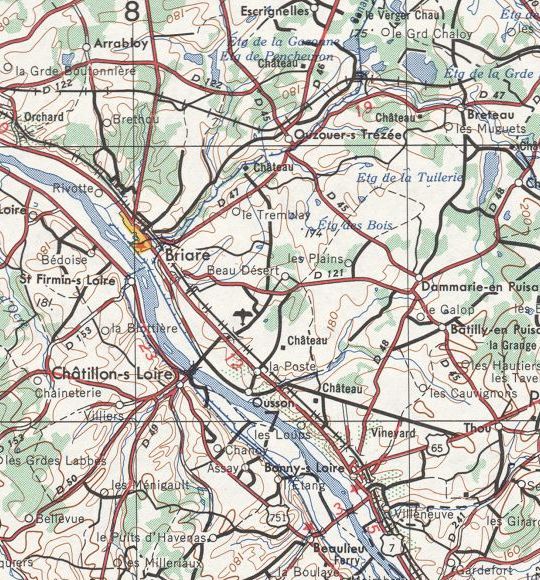
Part of map NL-31-2 from the Perry-Castañeda Library Map Collection at the University of Texas at Austin.
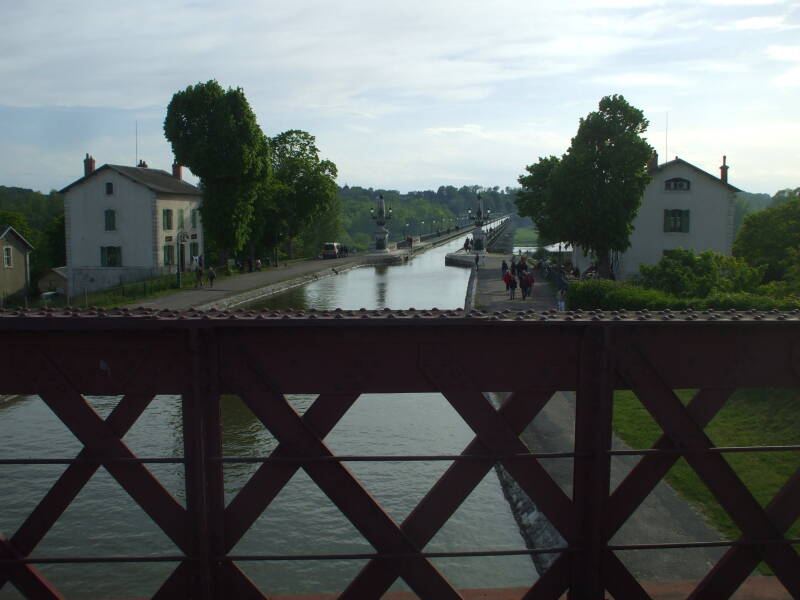
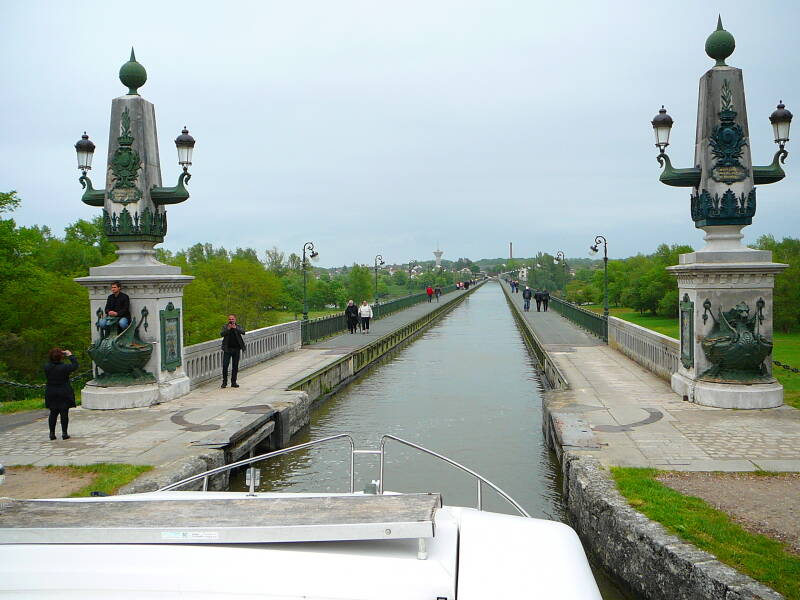
Saint-Firmin-sur-Loire
Saint-Firmin-sur-Loire is the first village you pass south of Briare, just across the Loire River and close to the west end of the canal bridge.
More onSaint-Firmin-sur-Loire
The area was inhabited from the Iron Age into the 5th century. It was then largely abandoned until a church was built in the 12th century, as an annex of Saint-Brisson. The settlement was recorded as Apud sanctum Firminum in 1241 in the charters of Saint-Benoît-sur-Loire. The church was enlarged in the 16th century.
Firmin of Amiens was born in Pamplona in the 3rd century, the son of a Roman of senatorial rank. Firmin was baptized as a Christian by Saturnius, who was martyred by having his feet tied to a bull and dragged until dead. Firmin was ordained in Toulouse and returned to Pamplona as its first bishop. He was beheaded in Amien on September 25, 303, and buried there.
Many miracles were ascribed to Firmin's grave — it emitted a sweet-smelling odor, sprouted flowers out of season, and surrounding trees "reverently bowed" toward the grave. Firmin's relics were taking to Pamplona in 1196. His relics, and his mentor's death by bull, led to the annual Running of the Bulls on July 6–14.
The village and especially the church was largely destroyed during the 17th century in the Wars of Religion. The church was restored and improved in the 19th century, with the addition of a covered stone porch.
There were 536 inhabitants in the 2013 census.
The area around the village is one of the few areas of limestone in the middle Loire. Compare this to the area much further downstream around Saumur which is almost entirely very soft limestone.
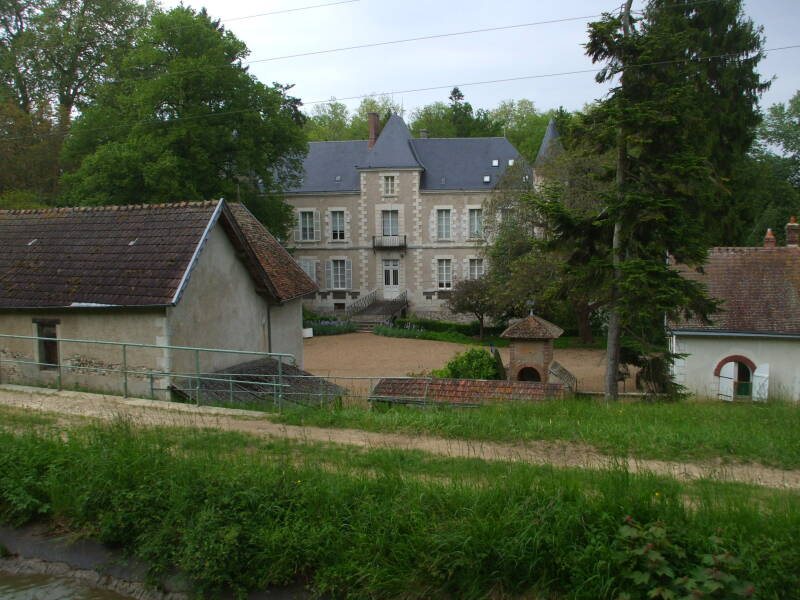
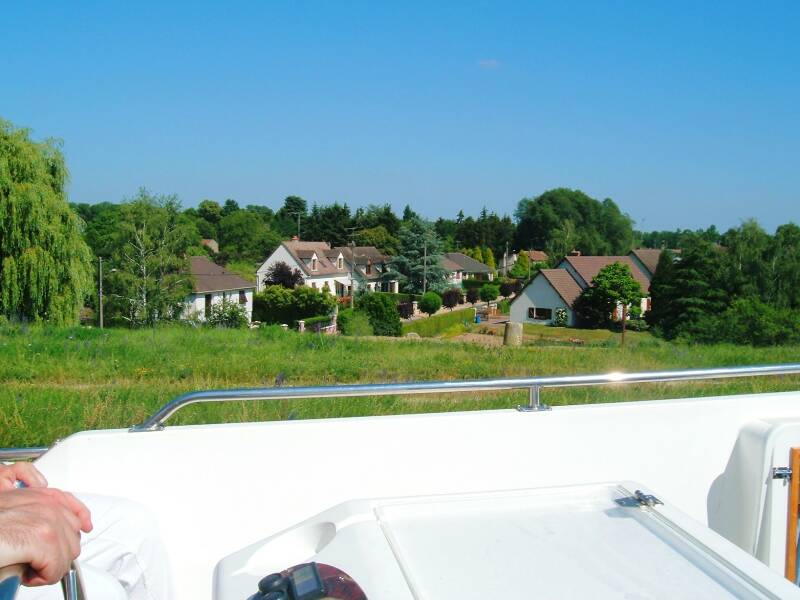
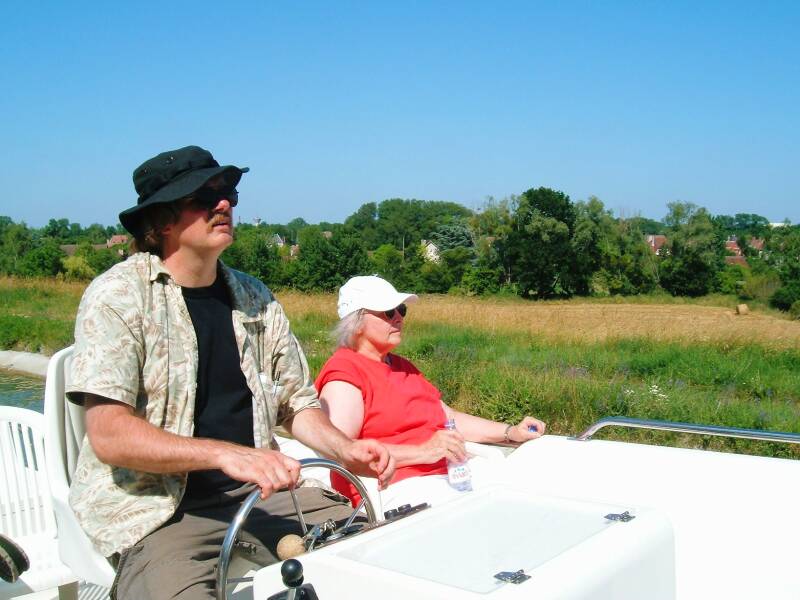
Châtillon-sur-Loire
The Canal Latéral à la Loire used to end here with the canal crossing the Loire between two dikes. That changed with the opening of the Briare canal bridge in 1896.
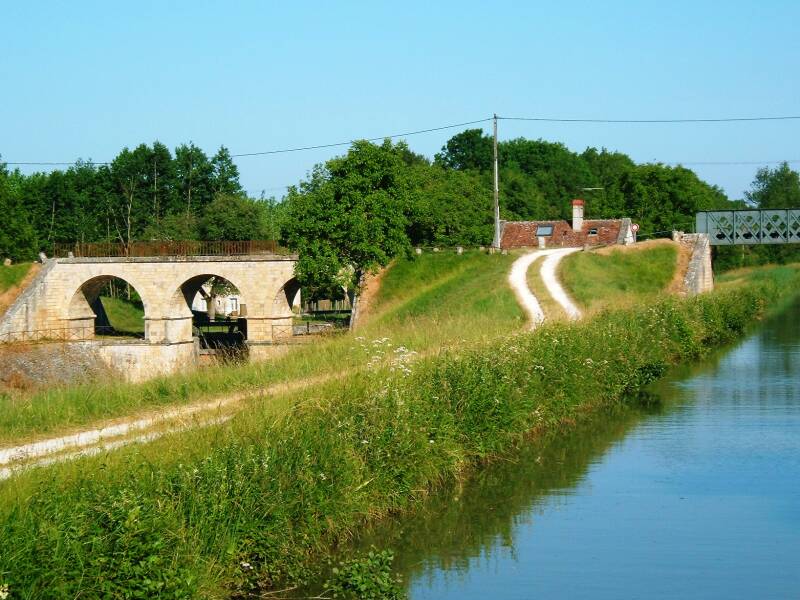
A branch of the canal is still there, with several locks that would allow transferring a boat between the canal and the river. In the picture above we're on the main canal, and the branch canal to our left is already significantly lower.
On our second trip we picked up our boat in the Châtillon-sur-Loire boat basin seen below. We walked into town and visited the grocery store. We selected and paid and then they delivered our purchases to the boat basin.
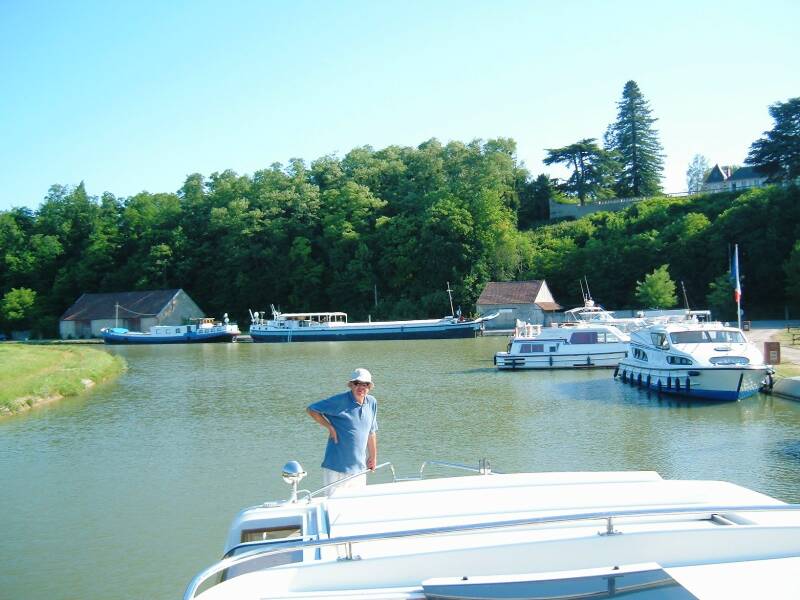
Bread, cheese, wine. The essentials, of course.
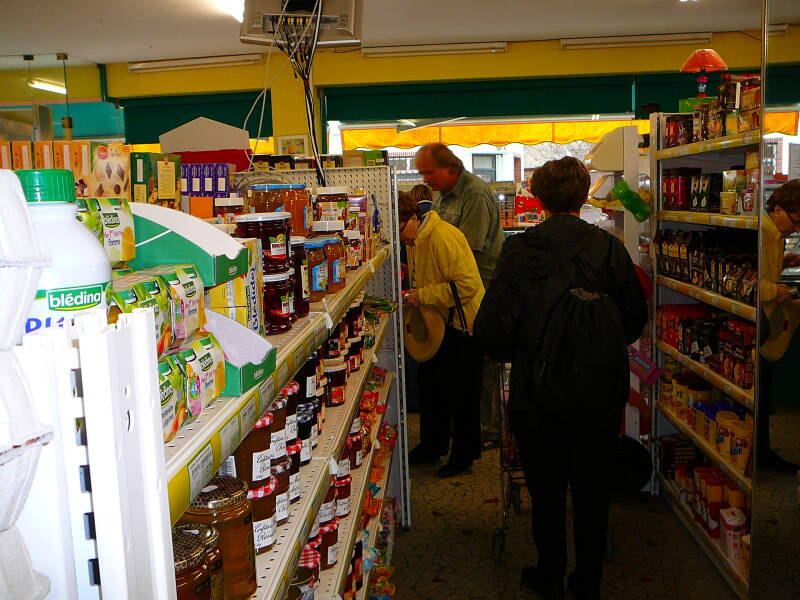
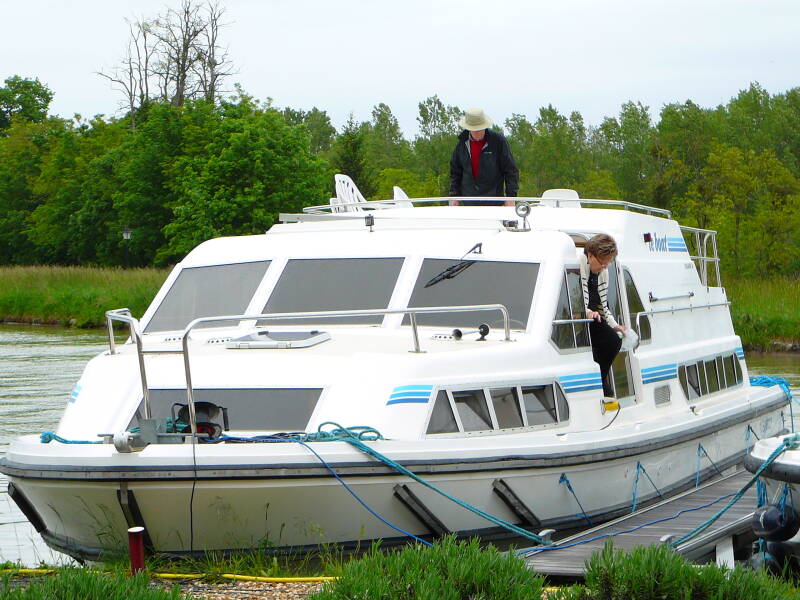
Châtillon-sur-Loire
A fortification at Châtillon-sur-Loire was mentioned in the 10th century. The upper town is the medieval district with many houses from the 15th through 18th centuries.
From 1820 until the present the population has varied between 2,000 and 3,400. There were 3,145 inhabitants at the 2013 census.
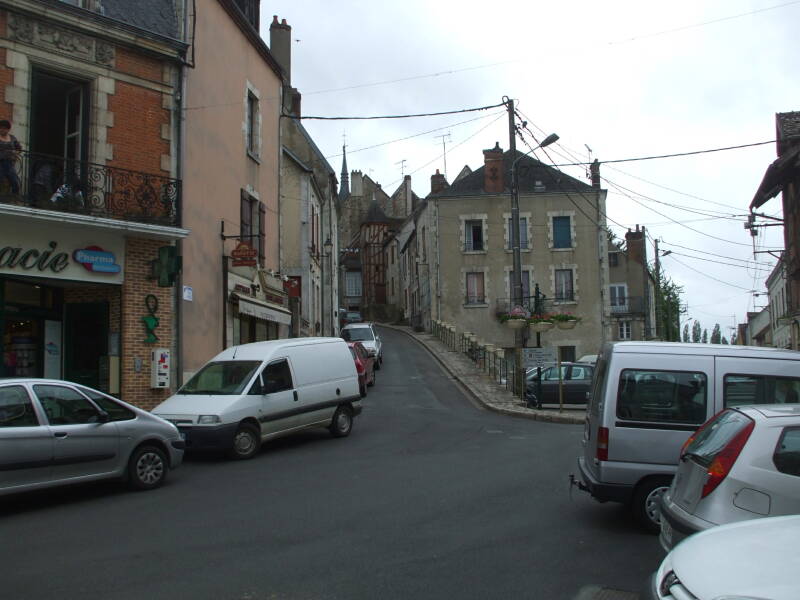
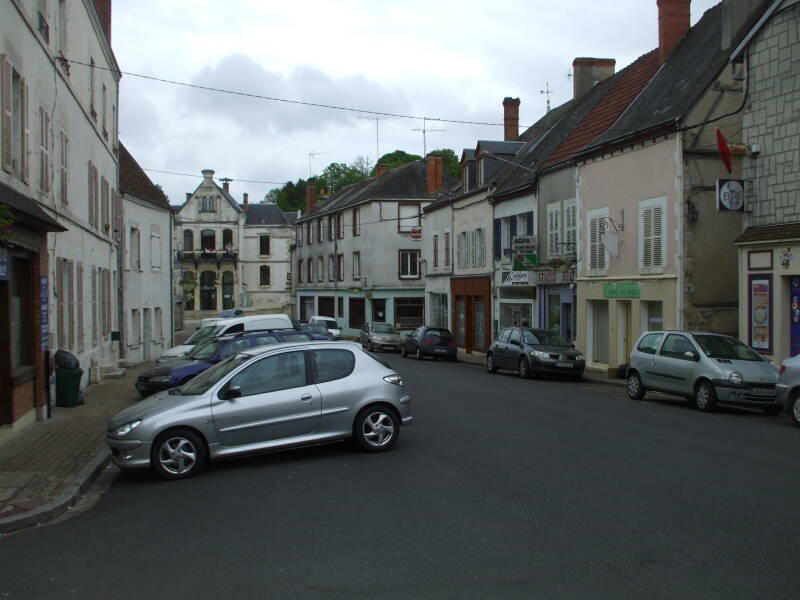
The last picture above shows the Protestant church that was built after the Wars of Religion came to an end. Or, as the somewhat alarming French terminology puts it, "The temple of the Protestant cult."
The French Wars of Religion
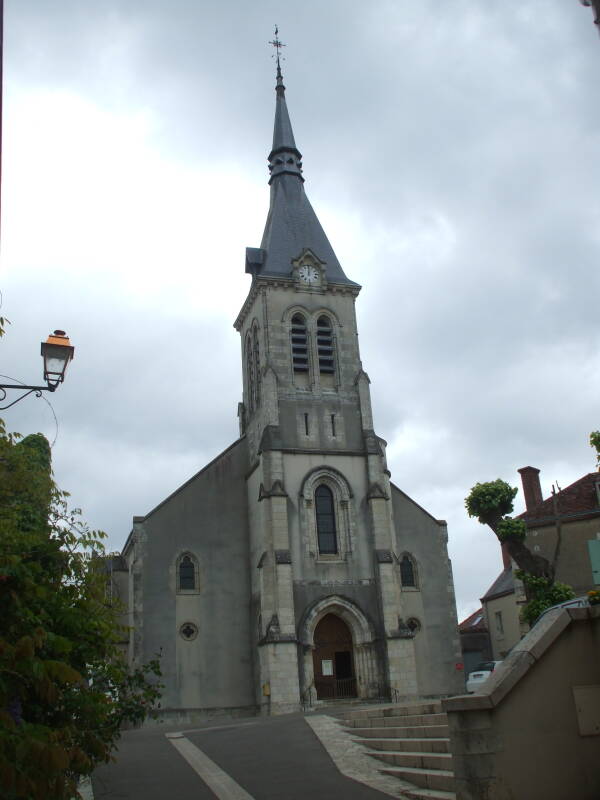
A château-fort, essentially a fortified village, was built here in the 13th–14th centuries. At its center was a crypt with the tomb of Saint Posen, born in Santranges in the 5th century. Posen was a hermite and the first curé of Châtillon. The Church of Saint Maurice was built next to that crypt. It was associated with the Abbey of Saint Benoît.
The Wars of Religion were awful for both sides in this area and throughout France. The Church of St Maurice was heavily damaged and the Protestant Temple was destroyed. The Church of St Maurice was later renovated with the support of Cardinal Richelieu himself in 1627.
The Wars of Religion in France were conflicts ranging from local unrest to national military operations between the Roman Catholics and the Protestants, lasting for many decades. A series of Kings were heads of government, and they issued edicts granting some rights to non-Catholic Christians. But every time, powerful Catholic families and alliances would support violent protests and massacres, and eventually led Catholic private armies into action against Protestant private armies and the King's forces.
It's generally accepted that the Wars of Religion began with the Massacre of Vassy in March 1562. One view is that the Edict of Nantes in April 1598 brought them to an end, another is that they didn't really end until the Peace of Alais in 1629. Even that didn't end religious conflict and suppression. The long horror of the Wars of Religion had a lot to do with why the French Revolution attempted to simply do away with religion.
At least 2,000,000 to 4,000,000 people were killed as a result of massacres, military action, famine, and disease associated with the Wars of Religion.
The Renaissance spirit inspired Francis I, King of France ruling 1515–1547. He established royal professorships in Paris to encourage the study of the classics, giving more people the knowledge needed to understand the classics and the original scriptures. That trend led, unfortunately, to the Wars of Religion.
Francis's royal college and the spread of the printing press allowed for inexpensive mass-produced books and the ability to read them. Now information could quickly spread across borders. This led to the reading, study, and translation of the early church fathers and the New Testament from their originals without relying on medieval commentaries. Renaissance scholars argued that the study of Scripture required an understanding of the Greek language in which the New Testament was written and the Hebrew language of the Old Testament. This was in stark contrast to the Medieval reliance on the Vulgate Latin translation of the Bible.
There certainly were some entertainingly bad Popes, including
Pope Stephen VI
(896-897), who exhumed the corpse of his
predecessor and put it on trial.
He found the corpse guilty, stripped it of its sacred
vestments, cut the three blessing fingers off the right hand,
dressed it in layman's clothes, and reburied it.
Then he had it immediately re-exhumed and
thrown into the Tiber River.
This came to be called the
Synodus Horrenda
or the
Cadaver Trial.
Pope John XII
(955-964) gave land to one of his several mistresses,
murdered several people, and was killed by a man who
discovered the Pope in bed with his wife.
Pope Benedict IX
was Pope for three separate terms:
1032-1044 (starting when he was just 20 years old!),
April-May 1045, and 1047-1048.
He was forced out the first two times, and sold the office
in 1048 when he finally got tired of the hassle.
Pope Victor III (1086-1087) wrote of Benedict's
"rapes, murders, and other unspeakable acts of
violence and sodomy."
Pope Boniface VIII
(1294-1303) was satirized in The Divine Comedy by
Dante Alighieri.
He established the tradition of the Roman Jubilee,
which provided lots of profit (and scandal) for the church.
Pope Urban VI
(1378-1389) was described as lacking Christian gentleness
and charity.
"He was naturally arbitrary and extremely violent and
imprudent, and when he came to deal with the burning
ecclesiastical question of the day, that of reform,
the consequences were disastrous."
He famously complained that he did not hear enough
screaming when the Cardinals who had conspired against him
were tortured.
Pope Alexander VI
(1492-1503) was a member of the Borgia family,
which right away tells us that he's going to be interesting.
His uncle Alfonso was Pope Calixtus III, who made him
and another nephew cardinals when he was just 25.
Alexander VI fathered many children by his many
Papal Mistresses, one of whom was rumored to be
his niece or possibly even his daughter.
Pope Leo X
(1513-1521) sold indulgences to fund the renovation of
Saint Peter's Basilica,
and barely escaped a plot by a group of cardinals who
tried to poison him.
He squandered so much money on luxury and ceremonies that
he tried to make up for the losses by selling cardinals'
hats, memberships in the "Knights of Peter",
palace furniture, and statues.
Several Popes had been spectacularly corrupt. Even during the reign of a decent Pope, the clergy at large was clearly corrupted. Christian salvation had been reduced to a business scheme based on goods or works for sale. Martin Luther disagreed with the church's claim that you could purchase your freedom from God's punishment for your sins. Pope Leo X and Holy Roman Emperor Charles V demanded that Luther retract all his writings. He refused, and was excommunicated by the Pope and condemned as an outlaw by the Holy Roman Emperor.
Protestant ideas were first introduced to France during the reign of Francis I (1515–1547) in the form of Lutheranism, the teachings of Martin Luther. Then Calvinism, after the teachings of John Calvin, who was born in Picady in 1509 and fled France in 1536. Calvinism developed with large support from the nobility, perhaps starting in France when Louis Bourbon, Prince of Condé, was on his way home to France after a military campaign and he heard a sermon by a Calvinist preacher in Switzerland.
Meanwhile the French King Francis I opposed heresy, but the difficulty was in deciding just exactly what heresy was. That kept Francis on a middle path trying to heal or bridge the religious gap. At least for a while...
The Affair of the Placards started in 1534 when some protesters started putting up anti-Catholic posters. The protesters weren't Lutheran or Calvinist, but instead Zwinglian or "Sacramentarian." This prompted the Roman Catholic church to define everything other than Roman Catholicism as heresy. Francis I was pressured to repress all Protestants.
Meanwhile, Francis I was working to establish an alliance with the Ottoman Empire. He invited the Ottoman ambassadors to join him at the Cathedral of Nôtre-Dame where those arrested for taking part in the Affair of the Placards were executed by burning at the stake. I'm sure the Ottoman ambassadors were impressed.
The Massacre of Mérindol happened in 1545, in Provence east of Avignon. Provençal and Papal military forces attacked the town of Mérindol and between twenty and thirty surrounding villages. The Waldensian form of Protestant belief was common in this area of Provence. Hundreds to thousands of Waldensian believers were killed, and hundreds of men were taken captive and sent to labor in French galleys. Francis I and Pope Paul III approved of the action, and the Pope awarded Imperial honors to the massacre's leader.
King Francis I died in 1547 and was succeeded by his son, Henry II, who was even harsher toward the Protestants. In 1551 Henry II issued the Edict of Châteaubriand. It went beyond the existing prohibition of Protestant worship to now prohibit Protestant discussion of religion at work, in the farm fields, or at meals.
However, the Protestant numbers were growing and gaining power. In the 1560s there were 2 million Calvinists and over 1,200 Calvinist churches, and over half of the nobility had converted to Calvinism. The increasing support by nobility made for an increased threat to the king.
Henry II was hit in the eye with a fragment of a splintered lance during a jousting tournament in 1559. He died of septicemia 10 days later. While dying, he kept asking for his mistress to be allowed to visit but Queen Catherine denied her access. Once Henry was dead, Catherine exiled his mistress, who went off to live quite comfortably on her own properties. No galley slave position for her.
The crown passed to Henry's young son Francis II, who was only 15 years old. He was married to the 16-year-old Mary, Queen of Scots. That gave a huge amount of control to Mary's family, the very pro-Rome House of Guise who would drive much of the unrest and military action through the next thirty-five years.
Within a year, a group of disgruntled Protestant nobles led by Jean du Barry, seigneur de la Renaudie, tried to abduct Francis II and eliminate the Guise influence over the French throne. The royal forces discovered the plot, and arrested and executed hundreds who were suspected of being involved.
That led to even more back-and-forth criticism between Roman Catholic and Protestant factions. This was when the term "Huguenot" came to be used to refer to Protestants in France. It never meant anything specific about French Protestants, it seems to have been a Dutch pun based on the word Huisgenoten, making fun of the perceived conflict between religion and government in Switzerland. Apparently it was hilarious if you spoke early modern Dutch and followed Swiss politics. It was intended as a derogatory label in France, but it came to be a badge of honor for an oppressed group.
Protestant mobs turned in 1560 to iconoclasm, damaging or destroying images and statues in Catholic churches. Catholic mobs carried out violent reprisals in return.
Mind you, all these attacks and massacres and unrest but we're still not quite to what most historians consider to be the start of the Wars of Religion. But we're getting close.
Francis II died in 1560, and the throne passed to his 10-year-old brother Charles IX. Mary returned to Scotland, where four years later she married her first cousin, and three years after that his residence was destroyed in an explosion and he was found murdered in the garden.
Catherine de' Medici, Queen of Henry II and mother of Francis II and Charles IX, was the regent, a title for the adult supervision of underaged or otherwise unqualified royalty. The French nobility controlled private armies — the House of Guise on the Catholic side and the overwhelmingly Protestant nobility on the other. Catherine needed to preserve the independence of the throne. Roman Catholic herself, she dealt with the Protestant House of Bourbon to counteract the overly powerful House of Guise.
In January 1562 the government issued the Edict of Saint-Germain, allowing Protestants to worship privately within town and publicly outside of towns. The House of Guise was not happy with that development, so on March 1, 1562, a group of Guise retainers attacked a Calvinist service in Vassy-sur-Blaise in Champagne, killing the worshipers and most of the residents of the town.
This Massacre of Vassy led to open hostilities between supporters of the two religions. The two sets of private armies went to war. Groups led by various noble Protestants seized various cities — Orléans first, then Angers, Blois, Tours, Lyon, and other cities. Military forces fighting in the name of the royalty besieged those cities.
Catherine de' Medici negotiated a truce formalized by the Edict of Amboise in 1563. Neither side liked it, the House of Guise saw it as dangerous concession to heretics. The crown tried to bring the two sides together for the good of France in a fight to re-capture Le Havre, occupied by the English for a year. France expelled the English occupiers without gaining any religious unity. Then Charles IX declared his legal majority, ending his mother's regency. There were further battles, and massacres, and then the Peace of Longjumeau in 1568 re-affirmed the Edict of Amboise and its grant of religious freedom to the Protestants.
That, of course, led to the rise of various Roman Catholic leagues and confraternities. Protestant leaders went into hiding as large numbers of their followers were massacred. By September of 1568 the Edict of Saint-Maur had revoked the Protestant freedom to worship. Two months later the Dutch leader William I, Prince of Orange, led an army into France with an announced plan of supporting his fellow Protestants. However, his army was poorly paid and about to slip out of his control, so he gladly accepted the French crown's offer of payment and free passage to return to the Netherlands.
The Protestants assembled a large army, adding military forces from south-eastern France and contingents of German fellow Protestant military forces including 14,000 Calvinist mercenaries. They were funded by Queen Elizabeth of England, influenced by her spymaster Sir Francis Walsingham. The opposing Catholic forces were commanded by the Duke d'Anjou, who later became King Henry III, and included troops from the Papal States, the Grand Duchy of Tuscany, and Spain.
There were battles throughout France in 1568–1570, leading to the Peace of Saint-Germain-en-Laye and some religious concessions to the Protestants. The armies stopped fighting, while Catholic mobs continued periodic massacres of Protestants.
King Charles IX formed an open alliance with Protestant leaders, especially Admiral Gaspard de Coligny. Coligny and many of the other Protestant nobles gathered in Paris for the marriage of the Roman Catholic princess Margaret to the Protestant prince Henry of Navarre on August 18, 1572. Four days later an assassin shot Coligny in a failed assassination attempt.
The Duke of Guise and his followers feared that the failed assassination might lead to a Protestant coup, so they set out two days later to do the assassination right. They killed Coligny and several of his men in their lodging. They threw Coligny's body out of the window into the street. They then mutilated the body in general, then castrated it, dragged it through the mud, threw it into the river, pulled it out and hung it from a gallows, and finally burned it.
This was only the start of the Saint Bartholomew's Day Massacre, five days of killing as Catholic mobs massacred Calvinist men, women, and children, and looted their homes. About 2,000 Protestants were killed in Paris during those five days, and about another 8,000 more in a dozen cities across France over the following weeks. Both Pope Gregory XIII and Philip II of Spain celebrated what they perceived primarily as the prevention of a Protestant coup d'état.
1572–1573 saw more Catholic sieges of Protestant towns. In 1573 the Duke of Anjou was elected to the throne of Poland, and the Edict of Boulogne was issued, severely reducing many of the rights earlier given to Protestants in France. It granted freedom of belief, but non-Catholic worship was allowed only within residences within three towns.
Charles IX died in May 1574. His brother Henry, Duke of Anjou, had been crowned King of Poland. Learning of Charles' death, Henry secretly returned from Poland to France via Venice. He was crowned King Henry III in February 1575. He stopped an invasion the following year and made peace with Protestant forces allied with his younger brother in the Edict of Beaulieu.
The ultra-Catholic Henry I, Duke of Guise, was vehemently opposed to the Edict of Beaulieu because of its many concessions to the Protestants. Pressure on the throne from the Catholic League of the Guise led Henry III to retract many of the concessions with the Treaty of Bergerac.
The King's youngest brother and heir presumptive, now the Duke of Anjou, died in 1584. The next heir to the throne was the Calvinist Prince Henri of Navarre. This led to the War of the Three Henries.
King Henry III hoped to lead the Catholic League to a negotiated settlement that would end the ongoing civil war. The House of Guise would not hear of that, as they wanted to destroy all Protestants and split their assets with the King. They controlled the Estates-General and demanded that Henry defeat the Protestants in an open war. Henry said that he would if the Estates-General funded it, and they refused. There was a popular uprising in Paris and Henry fled the city. The Catholic League then demanded that Henry follow their direction, effectively taking control of the government.
Henry III had finally had enough. He called for an Estates-General meeting at Blois. Henry's guards lured Henry of Guise and his brother the Cardinal de Guise into a trap. The royal guards killed the Duke and the Cardinal, and imprisoned the Duke's son.
The Catholic League declared open war against King Henry III, who joined forces with his Protestant cousin Henry of Navarre to fight the League.
In July 1589, the Dominican monk Jacques Clément gained an audience with King Henry III. He drove a long knife into the King's spleen, and was immediately killed by the King's defenders. Dying much more slowly, Henry III called Henry of Navarre to his deathbed and begged him to convert to Roman Catholicism to prevent further warfare.
Henry of Navarre became King Henry IV of France, but did not convert. His forces held the south and west of France, the Catholic League held the north and east. There was fighting from 1589 through 1593. Henry's forces besieged Paris in 1590 and Rouen in 1591–1592, but both sieges were broken with the help of Catholic Spanish forces.
In 1593 Henry IV concluded "Paris vaut bien une messe" or "Paris is well worth a mass," and agreed to convert. He was a politique, a pragmatic politician. He was crowned as a Roman Catholic King at the Cathedral of Chartres in 1594. The Catholic League didn't believe that he was sincere, and maintained their military control of the Cathedral of Rheims and their opposition to Henry. He was finally able to enter Paris in March 1594.
Some Catholic League members were still actively working against Henry IV at the end of 1594, all of them supported by Spain. Henry declared war on Spain in January 1595, to show Catholics that Spain was using religion as cover for aggression against France, and to show Protestants that was wasn't a puppet of Catholic Spain. In addition, maybe he could take some Spanish territory. However, the war mostly consisted of the French king's forces fighting Catholic League armies within France.
By 1598 Henry IV was struggling to rebuild France. He issued the Edict of Nantes defining a rather grudging truce between the religious factions that had kept France in a state of civil war for the past 36 years. It was intended to end the Wars of Religion, although it didn't really do that. Henry had to pressure Parliament to pass it. Religious tension continued to affect national politics and drive local tension and violence for decades to come. Henry IV faced at least 12 assassination attempts. The last of those was successful, when the Catholic fanatic François Ravaillac stabbed Henry with a daggar when Henry's coach was stopped by traffic congestion in the Rue de la Ferronnerie.
Henry IV is said to have originated the phrase "a chicken in every pot" when he said:
"Si Dieu me prête vie, je ferai qu'il n'y aura
point de laboureur en mon royaume qui n'ait les moyens
d'avoir le dimanche une poule dans son pot!"
or:
"If God keeps me, I will make sure that no peasant
in my realm will lack the means to have
a chicken in the pot on Sunday!"
Religious conflict returned in the 1600s. King Louis XIII forcibly reintroduced Catholicism in southwestern France. In 1661 Louis XIV took the throne and began to ignore some of the provisions of the Edict of Nantes. In 1685 Louis XIV issued the Edict of Fontainebleau, formally revoking the Edict of Nantes and making Protestantism illegal in France. There was no new wave of religious warfare, many Protestants left France for Britain, the Dutch Republic, Switzerland, and Prussia.
Châtillon-sur-Loire in the Wars of Religion
Châtillon-sur-Loire town was dominated by Protestants through the 16th century, with a large Protestant church built in 1596. Catherine de' Medici, supported by Catholic nobility in the area, sent troops to try to impose religious peace in the region.
After open warfare between private armies ended with the Edict of Nantes, Cardinal Richelieu provided some of the funding for the reconstruction of the Church of St Maurice in 1627.
In the late 1600s Louis XIV selected some especially combative Catholic priests and sent them in to put an end to Protestant Christianity in the area. In 1684 Protestant Christianity was prohibited in Châtillon-sur-Loire, a year before it was prohibited nation-wide. The Protestant church was destroyed by the orders of the king with the support of a decree of Parliament.
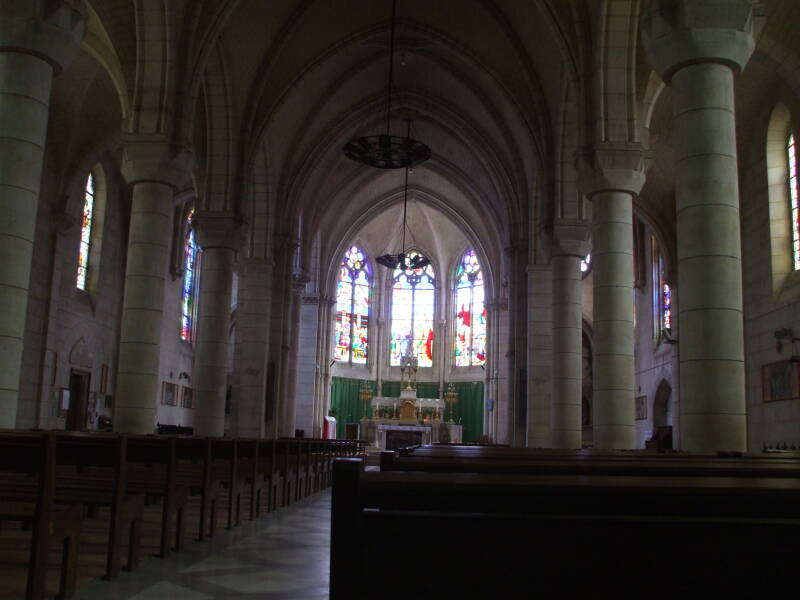
Highlights today within the Church of Saint Maurice are the polychrome wood statue of the Virgin from 1628, and the monumental tabernacle from that same period.

Châtillon-sur-Loire is in the area of an AOC or Appellation d'origine contrôlée, or "controlled designation of origin," for crottin de Chavignol. That's a soft cheese manufactured from raw whole goat milk, cylindrical and slightly convex at the periphery with mold in the rind. Yes, crottin literally translates as "goat dropping" because of its shape. It's molded into a shape like an ancient clay lamp or crot, from which the word crottin is derived based on similar shapes.
Beaulieu-sur-Loire
More onBeaulieu-sur-Loire
Beaulieu-sur-Loire is a small town with about 1,800 inhabitants. Agriculture is the main business, this area is the Coteaux du Giennois wine AOC, producing white (Sauvignon) and red (Gamay Beaujolais and Pinot).
Wines have been produced here at least since the 6th century. The establishment of several nearby abbeys in the 12th century increased wine production.
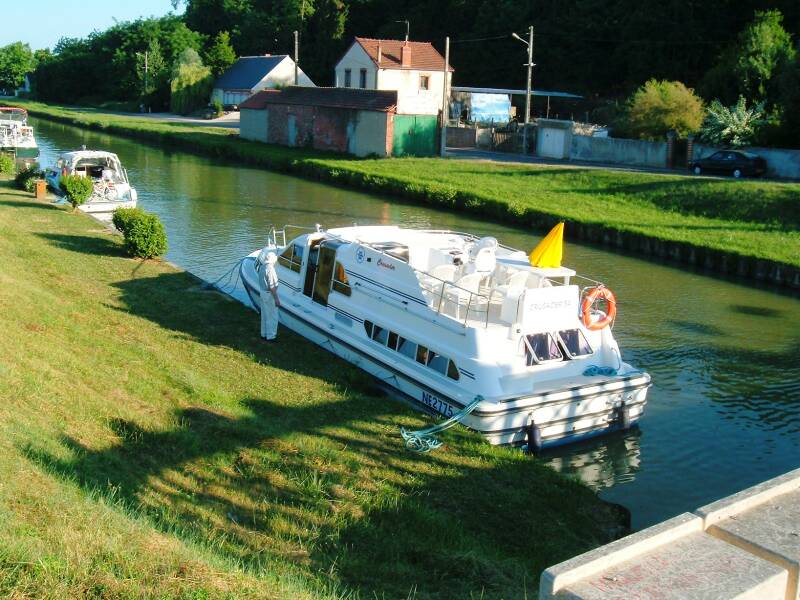
We will tie up here for the night, getting dinner in Beaulieu after exploring the town. The large Church of Saint Stephen was built in the 15th century.
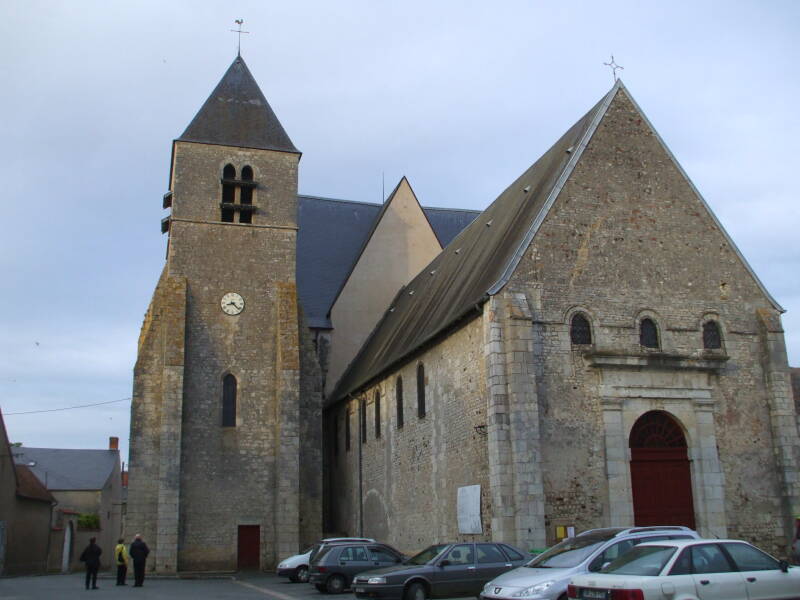
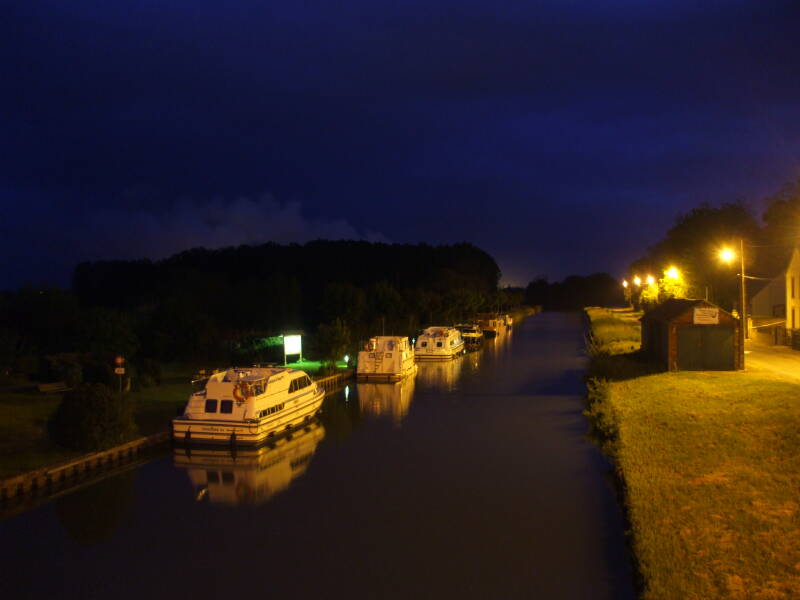
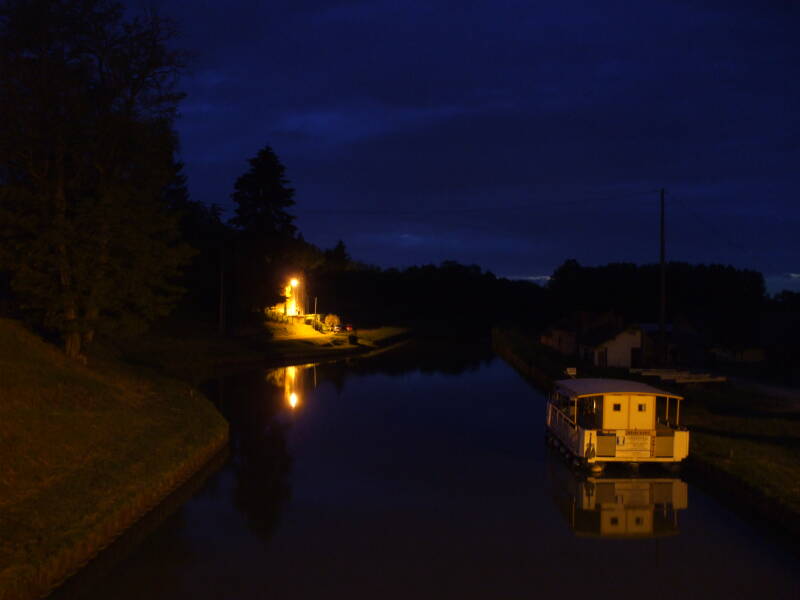
Bonny-sur-Loire is about the same size, just across the Loire and connected by a suspension bridge. Its history details are a little more evident, with signs of local habitation going back to the Neolithic.
The Celts called it Bonos and the Romans modified that to Boniacum, which was later modified to Bonnay Bonneia. Bonny was a junction of three Roman roads, making it the most prominent settlement in the area.
In the Merovingian times of the late 500s, the bishop of Auxerre had enough purported relics of Saint Peter and Saint Paul to distribute them to the new churches in his diocese including the church in Bonny.
Moving into Carolingian times, a period from 751 up to the 10th century, Bonny became a stop on the pilgrimage paths of Jerusalem and Saint Jacques de Compostelle.
The town flourished. In the early 1200s it was designated a city by King Philippe Auguste. It was enclosed by walls six meters high, with four gates and nine towers. A second church, the Saint-Aignan, was built near the Church of Saint Peter and Saint Paul.
The town was heavily damaged in 1429 during the Hundred Years' War. It was restored during the Renaissance, to the point that King Louis XI visited in 1480. Both churches were restored and a monastery was built.
Then the Wars of Religion arrived. Protestant forces seized the town in 1562 and Catholic forces besieged it in 1568. The protective walls were breached, the monastery was destroyed, and the Church of Saint Peter and Saint Paul was seriously damaged.
Then there was a long series of alternating reconstruction, plague, wine production, and debt. An unusually high flood of the Loire in 1707 destroyed lots of infrastructure, and the Grand Chemin or main highway from Paris to Lyon was no longer routed through Bonny.
Pope Pius VII stopped in Bonny on his way to crown Napolean in Nôtre-Dame de Paris, but Bonny continued to lose influence. The Canal Latéral à la Loire was built on the opposite side of the river, and then rail transport began to take over from shipping.
A suspension bridge was built across the Loire to join Bonny and Beaulieu in the early 1900s. It was destroyed in 1940 and rebuilt after World War II.

